Apple iPad mini with Retina Display: Reviewed
by Anand Lal Shimpi on November 16, 2013 8:00 AM EST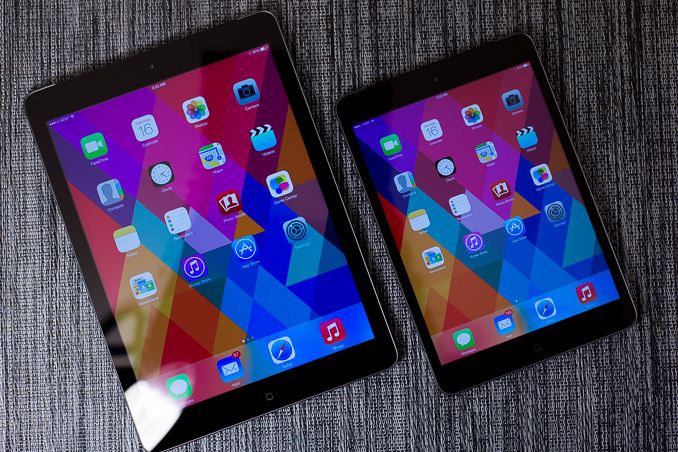
I suppose there’s only one way to start this review, and that’s by looking back at last year’s iPad mini review. In that review I had a section dedicated to the possibility of an iPad mini with Retina Display. The low resolution display and slow SoC were my only two real complaints about the first iPad mini. I listed a bunch of options that Apple had for the mini going forward:
“Apple has preferred outright quadrupling of pixel count (2x in each dimension) to create a Retina Display. With the mini's display using a 1024 x 768 resolution, this option would give it a 7.85-inch 2048 x 1536 panel. That would be the same resolution as the iPad 3/4, but in a much smaller display giving it a pixel density of 326 PPI (vs ~263 for the iPad 3/4). Apple could do this, but it would then need to make all of the same changes it made in going to the iPad with Retina Display, primarily the introduction of a larger battery and much larger SoC. The bigger battery is needed to drive the more powerful backlight, and the X-series of SoCs is needed to actually render the UI and games at such a high resolution. Both of these things would increase the size and cost of the mini, which would make it distinctly un-mini.”
What I wrote last year was more or less what Apple decided to do this year, had I stopped there I wouldn’t have ended up with egg on my face. Naturally I didn’t. At the end of that page I concluded the following:
“None of these options is particularly enticing for Apple, especially given the low (for Apple), starting price for the iPad mini. If you're expecting next year's mini to have a Retina Display, I wouldn't hold your breath.”
And this is why I don’t like making predictions.
I hadn’t expected display power to go down as much as it did. I didn’t think battery density would improve as much as it did. And I definitely didn’t think Apple would integrate a large 4MB cache on its SoCs, thereby reducing the need for a super wide memory interface. The combination of those three things made giving the iPad mini a Retina Display possible, and that’s exactly what Apple did this year.
It’s called the iPad mini with Retina Display, and unlike the iPad Air, it looks a lot like its predecessor. You’d be hard pressed to notice the 4.1% increase in thickness (+0.3mm) or the 7.5% increase in weight (+23g). Even if you did, what those slight gains net you is more than worth the effort.

From top to bottom: iPad mini, iPad mini with Retina Display, iPad Air
The Retina mini now features a 44% larger battery (23.8Wh). That’s nearly the same battery capacity as the original iPad (25Wh), but in a chassis with only 1/3 of the volume. This is also the highest capacity battery we’ve ever seen in a tablet of this size. The negligible impact on weight and thickness is pretty impressive.
The battery enables the two killer features of the new mini: mainly Apple’s A7 SoC and of course, the 7.85-inch 2048 x 1536 Retina Display. Effectively addressing my chief issues with the original iPad mini, the new mini is substantially faster and comes with a significantly better display. Keep in mind the original mini debuted with an n-1 SoC (Apple’s A5 the year the A6 came out), which makes the move to the A7 this year even more substantial of an upgrade. While casual users would be hard pressed to tell the difference between an A6 and an A7, anyone who actively used last year's iPad mini will appreciate just how much quicker the new one is (particularly if you’ve upgraded to iOS 7). It’s awesome silicon enabling a much better experience.
The display itself needs no real explanation. The first generation iPad mini featured a 1024 x 768 display, which was passable but not ideal. I had no problems recommending that mini given how good the rest of the experience was, but it’s clear that it could’ve been better. Moving to a 2048 x 1536 panel not only gives the mini the right to use the term Retina Display, but the title of highest density display in Apple’s lineup as well.
The rest of the chassis looks otherwise identical to the original mini. Apple likes to keep its mobile designs around for at least two generations, and the mini is no exception. By no means is this a complaint however. I'm just as enamored with the high quality mini chassis as I was last year. I think Apple nailed the size of the smaller iPad the first time around; 7.85-inches isn't too narrow nor is it too wide.
The face of the tablet is marked by an asymmetric bezel, identical to the iPad Air. The sides are narrow, while the top/bottom are thicker in order to accommodate the physical home button and FaceTime HD camera. Just like before, Apple does a little bit of extra work in rejecting thumbs placed on either edge of the mini to make up for the lack of side bezel to hold.
The back is a solid piece of aluminum, available in either a light silver or space (dark) grey finish. Just like with the iPhone, the silver model gets a white treatment on the front with a lighter chamfer while space grey comes with a black trim and gunmetal chamfered edge. Models with a cellular modem feature a plastic RF window along the top edge of the tablet just like the bigger iPad.
Along the edges you’ll find power/lock up top, volume up/down and a rotation lock/mute toggle on the right side. If you have a cellular model you’ll also find a nano SIM tray along the right side of the mini.
The bottom edge is home to Apple’s Lightning connector, flanked on either side by speakers. The mini sounds pretty good although you do get better low frequency reproduction out of the larger iPad Air.
The iPad mini with Retina Display features the same 5MP iSight (rear facing) and 1.2MP FaceTime HD (front facing) cameras as the iPad Air. Complementing both is a dual-mic setup for background noise removal, once again identical to the iPad Air.
The mini is available in the exact same configurations as the iPad Air. It starts at $399 with 16GB of storage, and is available in 32/64/128GB options (+$100 for each increase in storage level). Cellular connectivity is also an option, once again at a $130 adder. Just like the iPad Air, the mini with Retina Display is only available in a single LTE SKU with support for 14 different bands and ships unlocked.
| iPad Specification Comparison | ||||||||
| Apple iPad Air | Apple iPad 2 | Apple iPad mini (Retina) | Apple iPad mini | |||||
| Dimensions | 240 x 170 x 7.5 mm | 241.2 x 185.7 x 8.8mm | 200 x 134.7 x 7.5mm | 200 x 134.7 x 7.2mm | ||||
| Display | 9.7-inch 2048 x 1536 IPS | 9.7-inch 1024 x 768 IPS | 7.9-inch 2048 x 1536 IPS | 7.9-inch 1024 x 768 IPS | ||||
| Weight | 469g (WiFi) | 601g (WiFi) | 331g (WiFi) | 308g (WiFi) | ||||
| Processor | Apple A7 (2 x Cyclone 1.4GHz, PowerVR G6430) | 1GHz Apple A5 (2 x Cortex A9, PowerVR SGX543MP2) |
Apple A7 (2 x Cyclone 1.3GHz, PowerVR G6430) |
1GHz Apple A5 (2 x Cortex A9, PowerVR SGX543MP2) | ||||
| Connectivity | WiFi , Optional 4G LTE | WiFi | WiFi , Optional 4G LTE | WiFi , Optional 4G LTE | ||||
| Memory | 1GB | 512MB | 1GB | 512MB | ||||
| Storage | 16GB—128GB | 16GB | 16GB—128GB | 16GB—64GB | ||||
| Battery | 32.4Wh | 25Wh | 23.8Wh | 16.5Wh | ||||
| Starting Price | $499 | $399 | $399 | $299 | ||||
The old mini still sticks around at $299, although like the iPad 2 that’s still on sale you’d be hard pressed to hear me recommend it. Perhaps if you really don’t mind the lower resolution display, far slower SoC and want to save a little money without abandoning iOS. For most folks the iPad mini with Retina Display is where it’s at. If you’re a heavy tablet user, the experience is really night and day. While the iPad Air’s form factor is what defined its experiential improvement, the iPad mini with Retina Display relies on the display and silicon to do the same.
Weight and Usability
So much of the experience of using a tablet is tied to the weight and distribution of said weight. The iPad Air is proof of just how true that is. Whereas the iPad Air straddled the line between comfortable one and two handed usage, the mini finds itself squarely in one handed territory. Picking up the mini after using the Air for a couple of weeks feels like I’m barely holding anything. The mini is by far the more comfortable of the two tablets to hold while lying down. Sitting upright I’m not sold on the weight loss being a huge benefit compared to the mini, but if I’m relaxing the mini is just so much nicer to hold.
| iPad Dimensions/Weight Comparison | ||||||||
| iPad | iPad 2 | iPad 3/4 | iPad Air | iPad mini (Retina) | iPad mini | |||
| Height | 243 mm | 241 mm | 241 mm | 240 mm | 200 mm | 200 mm | ||
| Width | 190 mm | 186 mm | 186 mm | 170 mm | 134.7 mm | 134.7 mm | ||
| Thickness | 13.4 mm | 8.8 mm | 9.4 mm | 7.5 mm | 7.5 mm | 7.2 mm | ||
| Weight | 680 g | 601 g | 650 g | 469 g | 331 g | 308 g | ||
The chassis is narrow enough where I can just barely get one hand around the entire thing and use it like a giant smartphone. If I hold the mini in both hands like a smartphone I can actually type away super quickly using my thumbs. The latter is a use case I found myself in pretty frequently as the mini is small enough that I’d be willing to carry it with me everywhere, particularly when in a case. While the iPad Air is too big to hold in portrait mode and comfortably type on with my thumbs, the mini is too small to hold in landscape mode and use like a regular keyboard. For typing out long emails like I would on a notebook, the iPad Air is the better option assuming I can get to a desk or can sit down. If I can’t have either of those things, the iPad mini is a better companion.
Apple sent an LTE model, which basically duplicated most of the functionality of my smartphone. With the LTE mini my smartphone stayed in my pocket more, although there are tons of combinations of small/large phone/tablet that you can enumerate for optimum computing these days. In many ways it’s like the discussion between small notebook + desktop vs. large notebook + docking station.
The mini’s smaller display does make reading some content a little more difficult compared to the big iPad. Reading, particularly given the new Retina Display, is pretty good on the mini. Small text is always easier to read when it’s on a larger display, but if you’re looking at content that’s properly formatted for a tablet you’ll be in good shape on the mini. I was asked to look into the comic reading experience on the mini and also came away pretty pleased. Text bubbles were definitely not as easy to read as on the iPad Air, but overall the experience was still good in most of what I read. Ultimately you don’t sacrifice a ton of functionality if you choose the mini instead of the Air. What you do lose, you definitely make up in portability. It’s really a question of where you’re going to use the tablet that’ll determine which one to go with.
Cases
Like the iPad Air, the iPad mini is light enough that using any sort of case adds a good amount of weight to the device (percentage wise). I found myself taking the mini out of its case to use, and just keeping it protected when on the go.
Since the mini hasn’t really changed in form factor, the two first-party cases are pretty similar to what we got last year (the covers work with both mini generations). Like its bigger brother, the mini is offered with an optional Smart Cover ($39) or Smart Case ($69) depending on how much protection you want.
Apple sampled me a black Smart Cover and a Product Red Smart Case for the iPad mini. I thought both looked great on the space grey mini. It’s worth pointing out that the red Smart Case is a less saturated color than the red Smart Cover I evaluated with the iPad Air.
The Smart Cover attaches to the left side of the mini with a magnetic hinge. If you’ve lined up the magnets properly, the attractive force is strong enough to support the weight of the mini if you pick it up by the cover (though I wouldn’t recommend doing so). Magnets in the edge of the cover furthest from the hinge signal sleep/wake on the tablet itself.
The Smart Case has the same sleep/wake functionality, but instead of attaching to the mini with magnets the tablet sits inside the case for protection on both sides of the tablet. The Smart Case is what I prefer to travel with, though it is far more difficult to get in/out of and obviously adds the most weight to the device.
Both covers feature the same three fold design and can double as a stand for the tablet. Since the previous mini used the same type of cover, the angle of the stand doesn’t change like it did with the Air.
The inside surface of each cover is lined in microfiber, while the outside is made of either soft-touch polyurethane (Smart Cover) or leather (Smart Case). Both do a good job of protecting the mini and neither showed excessive wear during my review period. I still have the 1st generation mini’s Smart Cover and that one appears to have held up well over the past year.


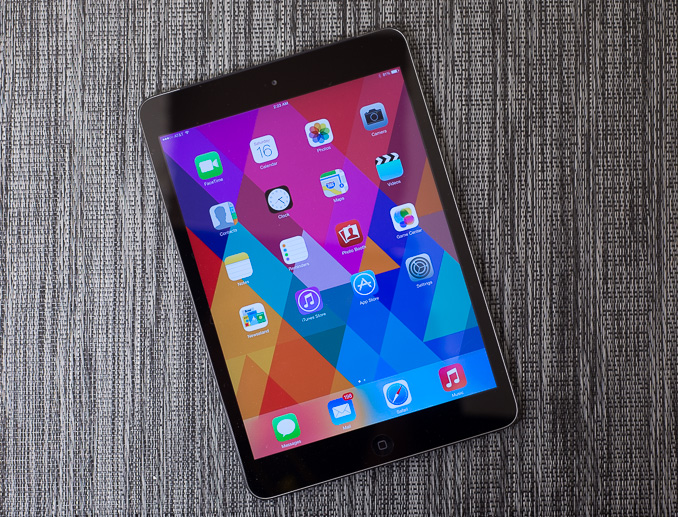
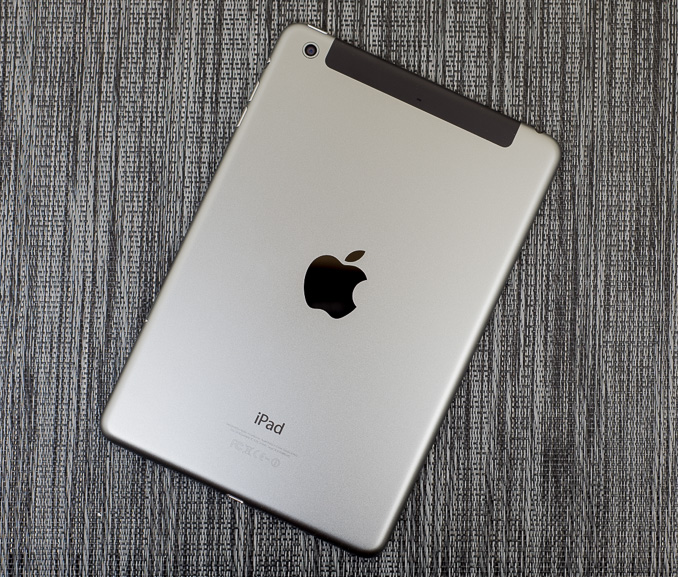
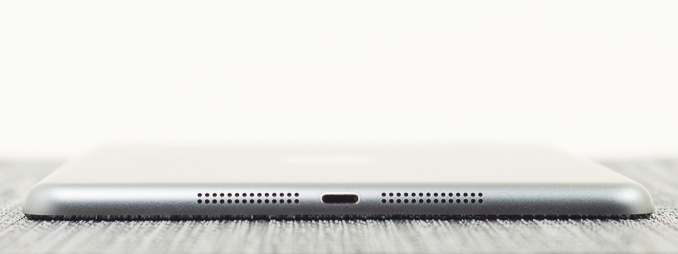






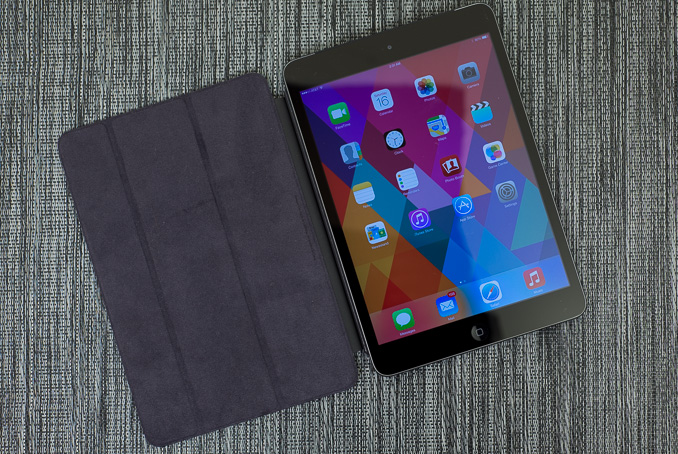
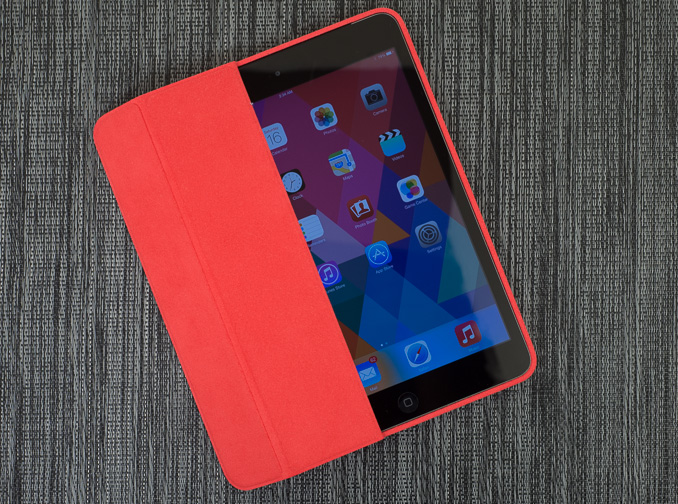









345 Comments
View All Comments
puggsly - Monday, November 18, 2013 - link
His point was much simpler than all of that. Things are worth what people will pay. If you can't build a product as fast as people are buying it, then you obviously didn't over price it. The problem with this is that if demand only out strips supply for a short time, maybe you did over price, which is possibly where the iPad Mini 2 will fall. People who really want the upgrade will justify the price but anyone on the fence may hold off. Most of this argument would be removed by killing off the 16GB version and shifting the line to 32GB @ $399 64GB @ $499 & 128GB @ $599 (maybe a 256?). This is a huge shift in value to the consumer for a trivial change in cost/margin to Apple and I believe would better maintain Apple's marketshare.ELPCU - Tuesday, November 19, 2013 - link
Ur argument has a point, and I sort of agree, but bis point is not that.he said, apple marin is not super high.
If he wants to say what u said, then he should not talk about "margin"
Freerange1 - Monday, November 18, 2013 - link
Go get yourself a good education! As you are clueless. All the other handset makers are losing money! Yet Apple's margins are too high? It should be obvious, even to a halfwit, that in fact the other manufacturers are too low! Duh! Even when adding more memory, there are more costs than just chips! You have engineering costs, manufacturing costs and assembly costs, packaging costs, labeling costs on the device itself, inventory and fulfillment costs, etc.Further, The other makers get the OS for free! While Apple's hardware margins also cover the cost of a much larger ecosystem, much better and more extensive customer support, IOS development, free software such as iWork, etc. Why do you idiots keep spouting off the same rediculous BS.? Back to school for you - you have failed!
ELPCU - Tuesday, November 19, 2013 - link
Nope, they just did not sell enough phones. Not all other handset makers are losing money. For example, Samsung makes a tons of money. Other top tier Android phone makers generally stays even or make some margin.I know non-top tier Android phone makers are losing money, and If we compare to Apple, there are not many company to even compare margin, because Apple makes ridiculus amount of margin, but that does not means other phone margin is too low.
I need to admit that OS development/investment is Apple's special investment with right direction, but Apple makes money out from OS due to App store. Yes, they gave you free software, but they have indirect way to make extra money for those investment.
Customer support is something Apple is doing decent. Especially in US, they are known as doing great job. But not throughout all the world. Especially for country without apple store, customer support of Apple is infamous for doing a terrible job. Also, Apple's policy is not flexible, which could be a problem for some customers.
For example, not all customers prefer exchanging to refurbish phone, but Apple's policy is usually just exchanging to refurb phone. In US, delivering back and forth takes at least usually more than 2 weeks, so most customers are happy about exchanging to refurb, but for example in Korea, delievering back and forth usually takes 2~3 days, so there are a lot of customers prefering just repairing their own phone.
akdj - Monday, November 25, 2013 - link
As an owner of Apple products for a couple of decades...and since the age of retail Apple stores, since the release of the original iPod I have NEVER, EVER seen a product replacement take 'at least usually more than two weeks back and forth'. NEVER. This is pure, utter Bull Pucky! Typically, if your item is under warranty, Apple will overnight a return box to you---and IF you have to ship it out (no Apple store in close vicinity), return times are EXTREMELY fast! Even full display and logic board replacements are sometimes as fast as 24 hour turn around times (once they've received it). Send it out Monday, sometimes...many times, you'll have it back by the end of the week.And whoever is taking BOM in to account as the ONLY pricing that goes in to each and every iPhone is forgetting the expense of R&D, machining, setting facilities, factories and employees as well as the Raw Materials necessary to build the new phone. Hence, and most likely the reason Apple typically gets two years out of each design package (see 's' models for iPhones, the iPad 3 and 4....even their computers tend to get 3-5 years out of their specific model). Fusion arc welding? Anodization of aluminum....they're definitely riding the cutting edge of plastics as well. The new FoxConn factory build out with machines/robots/computers for fabrication is going to cost well in to the billions this next year---in fact, wasn't it just released they've earmarked almost 10Billion for 2014 fabrication plants, re-tooling factories, training and R&D?
Apple DOES make money---they're smart about their manufacturing process, and they're the MOST successful selling specific makes and models....more than ANY other specific make or model from ANY other manufacturer. Yes...Samsung makes money, good money---about 20% of the overall 'profit' margin of the overall handset market. Apple? almost 75% of the OVERALL profit! That's amazing...especially with the build quality of each individual product, their ability to 'last', design, speed, eco-system, services continue to get better and better....post purchase support...Have you EVER tried to get a Samsung phone repaired? I have---the original Galaxy Note. Took almost 6.5 weeks to get it back, it was a refurb (not a repair) and I had a crappy 'loaner' phone from AT&T.
It's NOT Apple's fault they were so smart initially setting up their system with carriers (where the bulk of the money goes to Apple, not the carrier). No seller of the iPhone is making a profit, other OEMS are allowing subsidized profits to the carriers. Apple was absolutely Brilliant when it came to that negotiation....AND the reason AT&T was the only carrier in the US for a couple year, Verizon didn't want to take that 'no profit' from hardware challenge on...all the while missing those massive two year data contracts. THAT'S where the carrier money SHOULD be, in the service, NOT the hardware.
Would be cool if Android got more of a hand on this and helped Samsung slim down their TouchWiz BS (and bloat)....look at HTC's new Sense and it's lesser 'weight' on the UI. Check out the Google versions of the One or the S4. Much, Much smoother...and you can 'add' the launchers you want.
It's hilarious to read what a 'sin' it is for a company to make money. You SURE don't see people slamming Exxon everyday we're paying out our noses @ the pump!
Apple is smart, they're releasing exciting...fun products that are easy to use, yet powerful at the same time....they sport longevity, long battery life...more software available than at ANY other time in history for a single set of devices (iOS)----doesn't matter what you're into, 'There's an App for That!'----then, two, three years down the road when you want a new iPhone, or a new iPad, you can easily turn around and recoup 50-75% of the money you spent when you bought it new! That's amazing to me!!!! Try selling a two or three year old Windows laptop, a two year old Android plastic phone....or just look at 'completed' listings on eBay, that tells a whole 'nother side of the story! That money you HATE to give to Apple in the end, you get it right back in your pocket WITH another brand new, shiny, bad ass and FAST device of the latest iteration.
Win. Win.
ELPCU - Wednesday, November 27, 2013 - link
OK, Preeetty long reply both yours and mine, so let me break down.- I have not experienced sending Apple product, so I need to admit you probably right and I am wrong about returning service. But, my argument still stands. Apple service is generally good, and especially great in US, but it SUCKs in some countries such as South Korea which does not have apple store.
- BOM part : You clearly have not read some of my comment. I will copy-paste part of my comment for you. "Bill of material is not exact number used for calculating margin, because of warranty cost, marketing cost, licensing cost, etc, but if you uses 150% of BOM, which will give very close number of real unit price." The reason why I have mentioned BOM, because I do not have exact apple's unit price. Note I mentioned 150%, because iSuppli mentioned 1st gen Nexus 7 is about zero margin, and its BOM was 66.9% of MSRP. 66.9% is roughly 2/3, so it seems multiplying 3/2 is good enough calculation for me.
Again I know BOM is not exact number I want, but I am just roughly estimating, but all iphone BOM are around 200bucks, so 150% is 300 bucks. Considering unlocked iphone with lowest storage is 650 bucks, it still shows Apple makes more than 100% margin rate.
- "Apple DOES make money" : Let's face it. This is just not right way to describe Apple's margin. Right way to describe is "Apple make A TONS OF money". You said samsung make good money, which is about 20% of overall profit of whole smartphone market, and describing Apple which takes 75% of overall profit of WHOLE smartphone market as just "does make money". Stop being deceptive.
Is making money is a bad thing? Nope. I know All company's goal making money.
Is making a tons of money is a bad thing? This one is kinda Yes.
Making a tons of money itself is not necessarily a bad thing, but generally company has done something ridiculus for making a ton of money.
You have mentioned Exxon, which is a great example of this part. Success of current major oil companies including Exxon comes from old Standard Oil company. Of course, Standard Oil is infamous due to monopoly as you know. Antitreust law break Standard Oil into several pieces, and some of those major oil companies took over some fracture of Standard Oil companies or companies like Exxon and Mobil were those broken Standard Oil companies. Although Standard Oil had been punished, current major oil companies comes from those remnant of monopoly.
Taking over some remnant of monopoly company itself is okay, but they are having excessive amount of market control-using old remnant of monopoly-is something we do not want.
Yes, we do not talk too much about Exxon in everyday life, at least compared to Apple, but this is mainly Apple is rising star. People are just used to those oil company's control, so this is just less shiny issue. Also, nowadays there is a thing called OPEC, which is another big oil price controlling factor. So blaming only companies Exxon or Shell does not cover issue enough as well. However, no one like expensive oil price.
Back to Apple, Apple is not doing monopoly now, but they are doing some ridiculus thing for making the money. Most obvious one? Storage.
http://www.isuppli.com/Teardowns/News/Pages/Ground...
It shows BOM of iphone 5s, and if you look BOM difference btwn 16GB and 32GB, it is 9.4 dollar. 32GB -> 64GB? 10.2 dollar difference. Lets' rounds up, and say 10 bucks. Again, remember, 150% of BOM is break-even, so If Apple make us to pay 15 bucks for storage upgrade, then it is even. Note they are already making a lot of money elsewhere, too, so break-even is not super generous thing in this case. However, you are paying 100bucks for every storage.
As you know, this storage increase is nothing relavant to Apple's service quality or their investment for new fab. And, I am sure Apple do not need THAT much of money for developing nice and great new product or providing great service.
Even without those storage price increasing aka being a BS, Apple make a TONS of money, but they are still not satisfied, so makes more money by doing BS thing. Yet guy like you still cheer Apple so happliy.
Note monopoly was not illegal a long time ago. I mean more than 100 years ago. The reason why monopoly is bad, because they are forcing customer to buy product with ridiculus price. Apple is kinda doing similar thing. If we talk about a common laptop, I do not care much about storage, because I can swap HDD myself. If there was a SD card slot, I will not care too, because I will put microSD card. If Apple let other company to use their iOS(I know there will be a ton of tech issue such as optimizing issues or compatibility issue, but it is just one of if. Stop being nitpicking about my argument.), so I can have a light and decent iOS device, then I will not cry this much. But Apple is doing none of them, which force me to buy device with higher storage AND they set up ridiculus price. Doing fairly similar thing compared to monopoly. Forcing customer to buy item with ridiculus price
There should be no excuse for this BSing. this is not Win Win by any mean.
Another deceptive thing about having low storage is that review became deceptive.
All freaking review said iPad cost 499, but in reality, 16GB is just not enough for iPad user.
And review talks about Price/performance considering iPad cost just 499.
To me, it just sounds like iPad cost starts like 599. Not just because 16GB iPad user feels lack of storage but also because Apple is intentionally holding its storage. 16GB was first gen iPad's base storage. IT IS STILL SAME for 5th generation!!
Another thing is an expensive Apple accessory with their own standard cable.
Making their own cable is not necessarily terrible thing, but their accessory is ridiculusly expensive. and when 3rd party company starts to make a lot of accessory, they change their connector to new freaking lightning connector without any good reason! If there was at least decent performance increase, I might understand, but advantage of having lightning connector other than 'small and able to use for both direction' is almost non-existance.
There were terribly expensive iphone 30pin docking station in the market already.
If you were the one who had something like B&W Zeppelin(600 bucks) with 30 pin, you probably won't be too happy. Yes there is adapter, which make it work, but it still harm overall look, which is one of big pro apple pdt has. Also, adapter cost you 30 bucks. tiny little adapter cost 30 bucks? that is 5 bucks at most!
Again, price of storage and accessory are not relevant to any of those OS investment. If Apple wants to make money for investment, then fair way to doing it, is increasing their base price of iphone and iPad, but they won't do it, because they knew it will reduce their customer, so they are being ridiculus.
pmarreck - Monday, November 18, 2013 - link
If the market supports a 100% markup over the cost of parts... Then frankly that's just capitalism, and that margin is well-deserved. It's not like it doesn't have any competitors! But if you are a spec numbers whore, then you can go nuts and get your Android powered device for less, and miss out on the raw fact that the whole can be worth more than the sum of the parts. In fact, that is EXACTLY how "value" is created out of nothing!ELPCU - Tuesday, November 19, 2013 - link
I did not said 'apple's margin is NOT well-deserved.'Despite of ridiculus amount of margin, people still want it, and I have no problem with that fact.
I just bought iPad Mini Retina 128GB Wifi. I know it has ridiculus margin, but I found out it is still worth to buy it, because I have used my iPad 4th gen tremendously a lot within a year, and I am sick of its small storage so I bought it.
I just mention it his statement "Apple's margin is not super high" is totally wrong.
akdj - Thursday, December 19, 2013 - link
I absolutely did NOT say "Apple's margin isn't super high"...NO Where! My point, and your counter was they don't make 75% of the profits....guess what, they DO! While Samsung enjoys 80% share +/-, Apple is enjoying nearly that same take in profit. That is again, FACT. Not BS. I understand BOM. I also understand ANY Flagship Android device also costs in parity with the iPhone 5s. Note 3. S4. HTX One. LG G2. There are certainly other options...but flagships, unlocked....are ALL 750-850 Bucks. All margins are high on consumer electronics....especially as the company's experience and reliability, speed and 'know how' improve. That said, you're arbitrarily throwing costs around when you're not in the know when it comes to SoC bottom to top configuration and design (A7). 64 bit A8 instructions set, new XCode to help developers in OSx to conform their apps....the 'R&D' if you will, as this is the FIRST TIME this has been done by an OEM! Qualcomm is apparently shell shocked. As is Samsung....and THEY baked the cookies! Lol....advertising, investing and inventing....buying other companies, and another probably 2300 'things' that go in to price per phone @retail. Not. Just. B. O. M.Lord
darwinosx - Tuesday, November 19, 2013 - link
Your numbers are way wrong and you are apparently somehow unaware that top end Android phones and and tablets cost as much as Apple devices. You would also be more credible if your spelling and grammar weren't so poor.